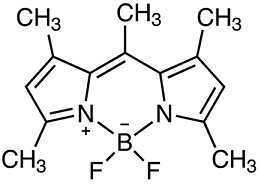All AbMole products are for research use only, cannot be used for human consumption.

ABDP 493/503 (same as BODIPY 493/503) is a lipophilic fluorescent probe that localizes to polar lipids and can be used to label cellular neutral lipid contents, particularly those localized to lipid droplets, in live and fixed cells. It displays excitation/emission maxima of 493/503 nm, respectively.

Int J Biol Macromol. 2025 Jan 18.
Downregulation of collagen IV deposition and ITGB1-FAK signaling pathway to inhibit adipogenesis: A novel mechanism of swertiamarin in treating type 2 diabetes mellitus
ABDP 493/503 purchased from AbMole

Phytomedicine. 2024 Oct 30.
Swertiamarin ameliorates type 2 diabetes by activating ADRB3/UCP1 thermogenic signals in adipose tissue
ABDP 493/503 purchased from AbMole

Inflammation. 2024 Feb 24.
Inhibition of Pyruvate Dehydrogenase Kinase 4 Protects Cardiomyocytes from lipopolysaccharide-Induced Mitochondrial Damage by Reducing Lactate Accumulation
ABDP 493/503 purchased from AbMole

Preprints with The Lancet. 2024 May 14.
The Discovery of a Novel Downstream Target of TGF-β Signaling, PRDM16 Mediates Renal Fibrosis
ABDP 493/503 purchased from AbMole

Arch Biochem Biophys. 2023 Mar 1;736:109535.
Ferrostatin-1 improves BMSC survival by inhibiting ferroptosis
ABDP 493/503 purchased from AbMole

Mol Biol Rep. 2023 Jan 14.
Andrographolide-treated bone marrow mesenchymal stem cells-derived conditioned medium protects cardiomyocytes from injury by metabolic remodeling
ABDP 493/503 purchased from AbMole

Front Pharmacol. 2021 May 17;12:589273.
Dapagliflozin Alleviates Hepatic Steatosis by Restoring Autophagy via the AMPK-mTOR Pathway
ABDP 493/503 purchased from AbMole
| Molecular Weight | 262.11 |
| Formula | C14H17BF2N2 |
| CAS Number | 121207-31-6 |
| Solubility (25°C) | DMSO Ethanol |
| Storage | -20°C, protect from light, dry, sealed |
| Related Fluorescent Dye Products |
|---|
| FITC Palmitate
FITC-Palmitate is a fluorescently labelled fatty acid derivative made by chemically coupling fluorescein isothiocyanate (FITC) with a long chain fatty acid, palmitic acid. Due to its combination of fat solubility and green fluorescent signals, it has a variety of uses in biomedical and cell biology experiments. |
| PGSK diacetate (5/6-mixture)
PGSK diacetate (5/6-mixture) is a metal ion-sensitive fluorescent probe that can penetrate cell membranes. PGSK diacetate can react with a variety of metal ions, including Fe2+, Cd2+, Co2+, Ni2+, Zn2+, etc. PGSK diacetate chelates Fe2+, resulting in fluorescence quenching, which can be restored when a membrane-permeable chelator is added, thereby reflecting the changes in the intracellular chelatable iron pool. The excitation/emission maxima of PGSK diacetate are 507/532 nm, respectively. |
| Dextran-Rhodamine B
Dextran-Rhodamine B (RB-Dextran) is a fluorescent marker made by combining rhodamine B fluorescent dye and dextran polysaccharide through a specific chemical reaction. RB-Dextran is a red fluorescent modified dextran polysaccharide formed by chemically labeling rhodamine B onto dextran molecules, which can be used in cell tracing, biofluid dynamics research and other fields, and its fluorescent properties can be used to track the distribution and metabolism of dextran in organisms and other processes. |
| N-Succinimidyl 6-(2,4-Dinitroanilino)hexanoate
N-Succinimidyl 6-(2,4-Dinitroanilino)hexanoate, the DNP-X acid modified by succinimidyl ester, is an amine-reactive building block for developing a probe, which can be recognized by anti-DNP antibodies. |
| FITC-Arachidonic Acid
FITC-Arachidonic Acid is a fluorescent labelled compound for biomedical research. FITC-Arachidonic Acid combines the biological activity of arachidonic acid and the fluorescent properties of FITC, and is suitable for the study of cellular signalling, lipid metabolism and so on. |
All AbMole products are for research use only, cannot be used for human consumption or veterinary use. We do not provide products or services to individuals. Please comply with the intended use and do not use AbMole products for any other purpose.


Products are for research use only. Not for human use. We do not sell to patients.
© Copyright 2010-2024 AbMole BioScience. All Rights Reserved.
